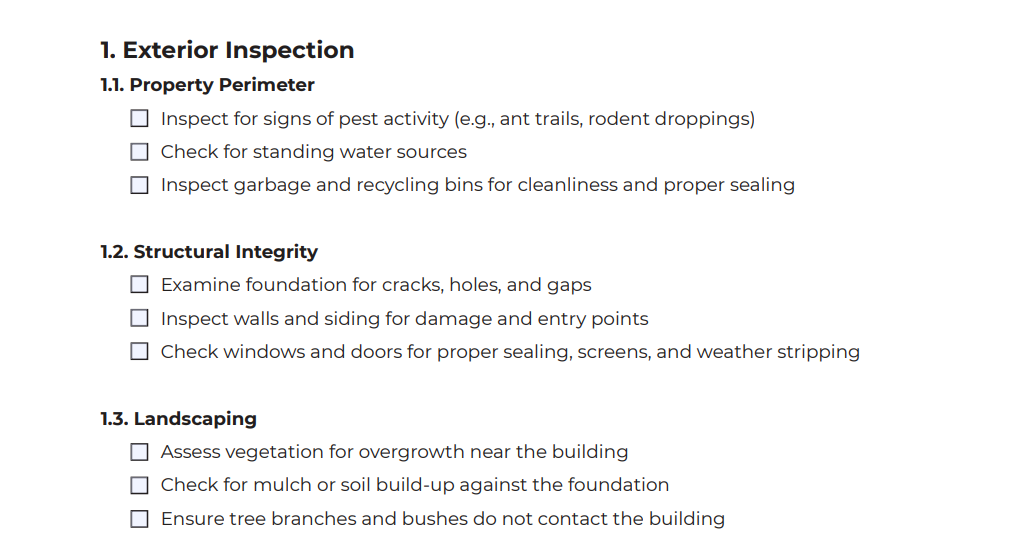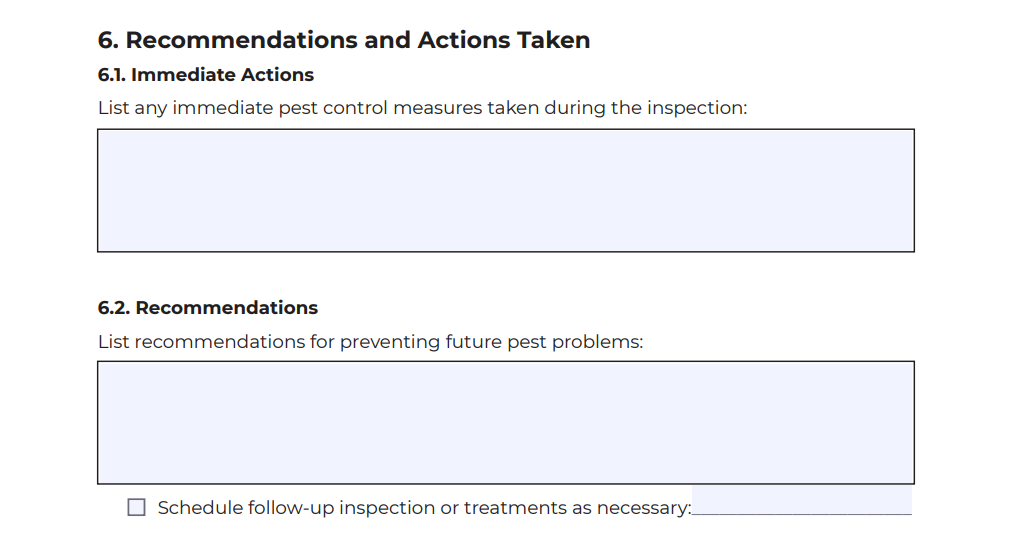Pest Control Audit Checklist (+Free PDF Download)
Successful pest control businesses regularly evaluate their practices and change course when results don’t meet expectations.
A pest control audit checklist offers a systematic approach to assessing your pest management practices, identifying potential issues, and implementing effective solutions to improve service delivery and enhance the customer experience.
In this article, discover the key components to include in a pest control audit, view a sample checklist, and download the free pest control audit checklist from FieldRoutes.
CTA: Download the Pest Control Audit Checklist
What Is a Pest Control Audit?
A pest control audit evaluates a home or commercial property to assess pest management practices and identify improvement areas.
A pest management audit includes these steps:
Inspect the premises for signs of pest activity
Assess the effectiveness of current pest management solutions
Ensure regulatory compliance and safety
Identify corrective actions to eliminate or prevent pest infestations
Pest control audits are a component of Integrated Pest Management (IPM). They promote public health, ensure a safe environment for occupants, and protect property from potential damage caused by pests.
Why You Should Use an Audit Checklist
Regular pest control audits promote a healthier and safer environment by eliminating pest-borne diseases and minimizing the use of pesticides and chemicals. It also ensures the applied pest control solutions address problems quickly and effectively.
Using a pest control audit checklist offers several benefits, including:
Ensure compliance with regulatory standards
Assess the effectiveness of current treatments
Promote health and safety
Enhance customer satisfaction
Reduce costs from ineffective practices
Taking a structured approach prevents pest control techs from overlooking critical steps in the audit process. An inspection checklist helps pest control companies document findings, monitor progress, and present the next steps to customers.
Pest Control Audit Checklist Sample
The checklist below breaks down the components of a pest control inspection report and includes action items and key steps.
Documentation review
Review site plans and confirm the location of pest control devices.
Ensure licenses and certifications are up to date.
Confirm pest sighting logs are on hand and up to date.
Confirm pest control practices comply with local regulations.
Facility inspection
Check for evidence of pest activity, including droppings, nesting, gnaw marks, grease trails, and structural damage.
Inspect the facility's interior, including storage areas, bathrooms, and kitchens.
Inspect the facility's exterior for overgrown vegetation, debris piles, and standing water.
Check for entry points, including around doors and windows, roofline, and foundation.
Check drains for signs of flying insects.
Monitoring devices
Ensure bait stations, traps, and pest control technology are correctly located as indicated on the floor plans.
Confirm monitoring devices are properly labeled and maintenance schedules are up to date.
Confirm monitoring devices are free of damage. Replace rodent baits and check battery life for applicable devices.
Regulatory compliance
Ensure pesticide usage logs are accurate and up to date.
Confirm pest control measures comply with local regulations.
Confirm technician applicator licenses are valid.
Employee training
Ensure employee training manuals are on hand.
Review employee training logs and confirm compliance.
Ensure employee training procedures align with IPM best practices.
Sanitation practices
Ensure the facility’s sanitation practices comply with local health regulations, including food safety and waste disposal.
Look for food sources that attract pests, such as uncovered items and spilled food.
Ensure all trash is disposed of in pest-proof containers.
Check trash removal schedules and ensure compliance.
Pest control procedures and practices
Ensure technicians follow Standard Operating Procedures (SOP) defined in the employee handbook.
Ensure pest control procedures follow IPM best practices and include the latest techniques.
Review the effectiveness of pest control practices.
Ensure technicians use pesticides in accordance with local regulations and manufacturer’s instructions.
Discontinue ineffective pest control measures.
Bonus: Pest Control Audit Report Template
A pest control audit report summarizes the findings and observations, audit methodology, and recommended next steps that result from an internal audit.
Download the pest control audit report template below and use it along with the pest control audit checklist.
CTA: Download the Pest Control Audit Report Template
Executive summary
The executive summary of your pest control audit report template provides a concise overview of the audit's key findings, conclusions, and recommendations. Briefly explain the reason for conducting the audit and highlight significant outcomes, including areas of non-compliance with regulations and weaknesses in current pest control measures.
Tailor the executive summary to the intended audience. The reader should understand the goals, outcomes, and suggested next steps from reading only the executive summary.
Introduction
The introduction explains the purpose and objectives and outlines the scope of the audit. It also provides background information on the client, home or business, and history of pest issues.
Audit methodology
The audit methodology describes the process, methods, and affected areas on the property or facility. The methodology section details the tools, equipment, and pesticides used during the audit and explains why they were chosen.
Findings
The findings include a more in-depth analysis of the audit results than the brief overview mentioned in the executive summary. They also evaluate current pest control methods, their effectiveness, and any shortcomings. The findings section should include photographs, charts, and supporting documentation.

Recommendations and action plan
Provide detailed recommendations to meet the objectives defined in the audit. Include strategies to address identified pest issues and preventive measures to enhance future pest prevention.
The action plan provides detailed steps to implement the audit's recommendations. It includes timelines for implementation, assigns action items to responsible parties, and mentions desired results.

Conclusion
Provide a summary of the key findings, an overall assessment of the effectiveness of pest control measures, and final recommendations and next steps in the inspection report.
Appendices
Include any supporting pest control documentation, photos, and data collected during the pest control audit.
Streamline Your Pest Control Audit and Reporting Processes
Pest control services conduct regular audits to assess existing pest management solutions, meet regulatory compliance, and ensure their pest control strategies work effectively for residential and commercial customers.
FieldRoutes Operations Suite gives pest control businesses modern tools to streamline scheduling, routing, payments, and reporting, driving business growth and profits. The all-in-one software and integrated mobile app help technicians take notes in the field, communicate with customers via text, and provide a superior pest control service experience.
Ready to modernize operations with cloud-based pest control software? Schedule a free demo of the FieldRoutes Operations Suite.